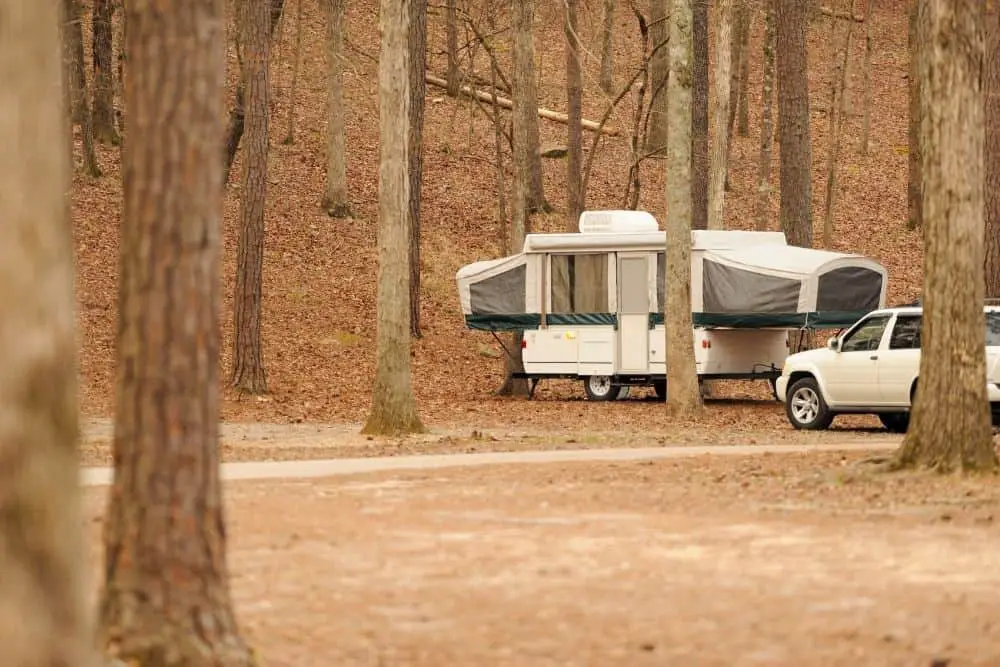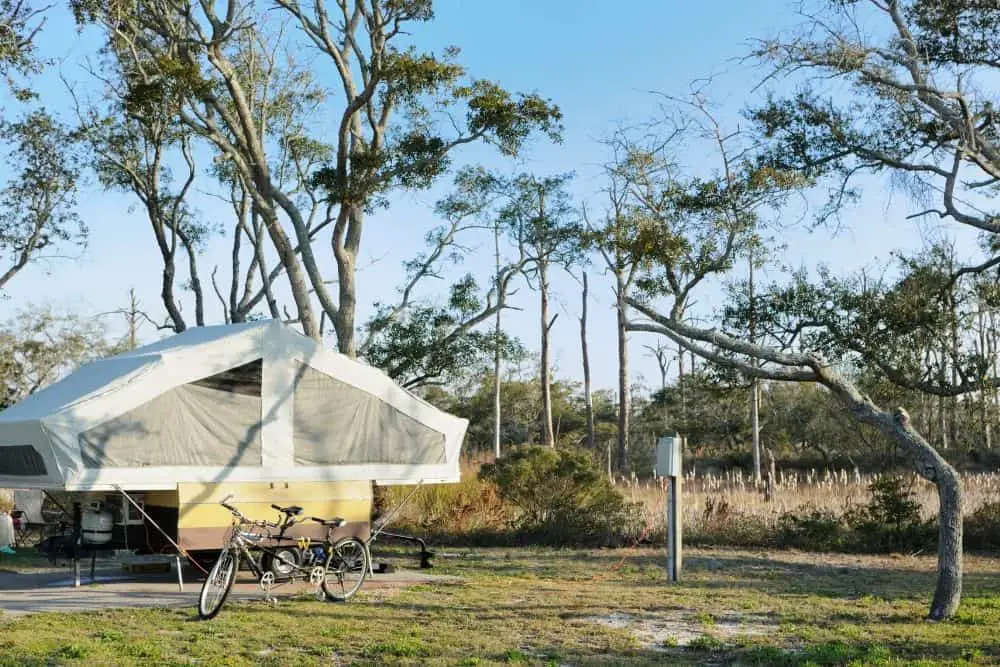Using a pop-up camper is a terrific way to get out in the fresh air. Compared to travel trailers, they’re more compact and less expensive. However, given their size, you may be concerned about how much weight the beds can support.
How much weight can a pop up camper bed hold? You can put 1,000 to 1,200 pounds on an ordinary pop-up camper bed. This may be different depending on the manufacturer. Pop-up campers will have a manual with normal weight and capacity restrictions listed in it.
If you’ve never used a pop-up camper before or just want to brush up on your skills, here are some pointers for making the most of your time with one.
What Is a Pop Up Camper?
Many campers and outdoor lovers utilize pop-up campers as a towable recreational vehicle. A pop-up camper is portable and can be collapsed and stored if you run out of room.
Pop up campers are popular because of their low cost. Towing an RV is much simpler with a travel trailer because of its compact size. A conventional pop-up consists of a trailer chassis, a box, a roof, pull-out bunks, and a wall structure. It’s not uncommon for the walls to be covered with vinyl or canvas instead of wood.
Pop-up campers resemble conventional residences in many ways. Additionally, it has many features such as an integrated dinette and water heater as well as a power system and storage banks. There’s only one thing missing from this set: a pop up camper bed!
Newer vs. Older Models
Many campers claim that current pop-up camper beds can support up to 1,200 pounds on each end. Campers also mentioned that their bunks were never an issue, even when the kids jumped on them. This weight is supported by newer versions, although earlier models from the 1990s may hold up to 700 pounds.
Travelers who like the outdoors often buy used pop-up campers. It’s important to read the instructions before buying. Get in touch with the business if you have not received one. Search for your camper’s make and model on their website for further information.
How Much Does a Pop Up Camper Weigh?
It’s helpful to know how much weight a camper bed can support so you can plan ahead of time. If you’re using a pop-up camper, make a mental note of how much it weighs so you can properly prepare for your journey.
When it comes to pop-up campers, the range is 600 to 2,800 pounds. Pop-up campers are much more compact than traditional travel trailers.
They also fold up small enough to fit in a small space when being stored. Using a pop-up camper is the greatest option for boondocking because it’s light and portable.
Tire Leveler
Instead of using blocks or ramps, consider buying a tire leveler for ease. A tire leveler is useful for securing your camper so you don’t have to be concerned about it shifting or sliding around at night.
Most have a ratchet to make raising and lowering the tire position simple. Furthermore, moving positions are made simpler with a leveler. In other words, if you’ve just set up camp and then realize there’s a better view up ahead, you can quickly modify your plans and be back on the road in no time at all
Extra Support for King-Sized Beds
Pop-up tent campers can still collapse despite having a conventional weight capacity limit. Variable factors, such as your energetic dog, can push the overall weight limit over the top.
For a king-sized bed, make sure to plan ahead and have extra support available. Here are a few helpful hints for while you’re out camping with your family or friends.
An adjustable cargo bar can be used to provide additional support for the bed. Strengthening the ground support with 2x6s can be accomplished through the use of a screw adjustment. Check out Keeper’s Ratcheting Cargo Bars! (view on Amazon).
Assemble the front bunk’s support in a T shape and the back bunk’s support in a H shape. Everything should be constructed using 2x4s, even if it isn’t a movable item.
Despite the fact that pop-up campers are designed to tolerate weight shifts, they do collapse on occasion.
How to Make Your Pop Up Camper More Comfortable
One of the best ways to unwind is to spend a night or several nights in the great outdoors. However, the idea of sleeping in the open air may not appeal to everyone.
A wonderful alternative to traditional tent camping is the use of pop-up campers. The experience isn’t quite like living in a travel trailer, but it’s also not like pitching a tent like you normally would. It lies somewhere in the middle. Here are a few things to remember to make your trip more enjoyable.
Mattress
To get started, you’ll need a decent mattress. Don’t forget to take your camper’s measurements before you buy a mattress.
If you have the space, opt for the eight-inch thick Zinus Deluxe Memory Foam (see on Amazon). Because of the memory foam, you’ll feel right at home in this bed. This Foam Mattress with Fabric Cover is ideal for medium-sized campers.
Bed sheets
Because it’s impossible to foresee the weather, it’s preferable to have sheets that can be used in every situation. Bamboo sheets are a good example of this. They are manufactured from the natural bamboo fiber and are quite thin. They keep you cool, wick away moisture, and resist odor.
Eggshell topper
An eggshell mattress topper can provide you with additional comfort. In addition to relieving muscle stiffness, an eggshell topper provides neck and back support. The 2 inch egg crate ventilated memory foam mattress topper from Milliard could be what you are looking for (view on Amazon).
Four Things to Remember About Pop up Campers
Prior to making the decision to buy a pop-up camper, think carefully about all of your options. Some campers, for example, come with all the bells and whistles and have all the latest gadgets. Every aspect of them is superb. However, it’s possible that this isn’t what you and your family need. Some considerations to keep in mind are as follows:
Pop up campers are not very spacious.
Large pop-ups are available, but they’re expensive. If money is an issue, the standard pop-up camper is a good option. However, bear in mind that with less room comes a smaller list of things you can fit into the camper.
Either way, the available space is compact. While a comfy pop-up camper bed can be set up, keep in mind that the sleeping area’s headroom will be reduced. In many cases, this is not an issue for campers.
Pop up campers have no air-conditioning or heater.
Pop-up camps are totally reliant on the elements. Because of their small size and lack of insulation, pop-up campers lack amenities like air conditioning and heating. Regardless of the season, you can always bring a portable heater or air conditioner with you to stay warm or cool when traveling.
Pop up campers are not immune to the weather.
Pop-up campers are unable to protect the inside space from bad weather since they lack insulation. While a pop-up camper will keep you dry and protected from the weather, there will be some dampness. As a result, your camper’s interior may be wet, so you’ll have to get used to opening the windows and doors frequently to let some fresh air in.
Pop up campers come with cassette toilets.
No need to stress about where to relieve yourself because pop-up campers come equipped with portable cassette toilets. If your camper doesn’t have a portable toilet you can use ones such as this Camco 2.6 Gallon Portable Toilet or the SereneLife Outdoor Portable Toilet with Carry Bag from Amazon, is an option as an alternative.
In Conclusion
A pop-up camper is an excellent, low-cost option if you enjoy dry camping. If you’re buying a used camper, do your research on the condition and level of restoration. Make sure you do your research! Before you buy, upgrade, or fix something, think it over thoroughly. It’ll make your journey a lot more pleasurable if you do this.



